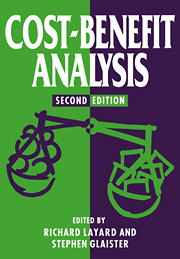Book contents
- Frontmatter
- Contents
- Introduction
- PART I THEORETICAL ISSUES
- 1 Shadow prices and markets: Policy reform, shadow prices and market prices
- 2 Shadow prices and markets: Feasibility constraints: foreign exchange and shadow wages
- 3 Discount rates: The rate of discount for benefit–cost analysis and the theory of the second best
- 4 Risk and uncertainty: Uncertainty and the evaluation of public investment decisions
- 5 Income distribution: Allowing for income distribution
- 6 The costs and benefits of analysis: Project appraisal and planning twenty years on
- PART II HOW TO VALUE THINGS
- PART III CASE STUDIES
- Index
3 - Discount rates: The rate of discount for benefit–cost analysis and the theory of the second best
Published online by Cambridge University Press: 24 November 2009
- Frontmatter
- Contents
- Introduction
- PART I THEORETICAL ISSUES
- 1 Shadow prices and markets: Policy reform, shadow prices and market prices
- 2 Shadow prices and markets: Feasibility constraints: foreign exchange and shadow wages
- 3 Discount rates: The rate of discount for benefit–cost analysis and the theory of the second best
- 4 Risk and uncertainty: Uncertainty and the evaluation of public investment decisions
- 5 Income distribution: Allowing for income distribution
- 6 The costs and benefits of analysis: Project appraisal and planning twenty years on
- PART II HOW TO VALUE THINGS
- PART III CASE STUDIES
- Index
Summary
INTRODUCTION
In this paper I wish to present a way of thinking about what the rate of discount ought to be for evaluating projects within the public sector. The conclusion of my analysis is that there is not a convincing case that the social rate of time reference ought to be used. Nor is there a convincing case that the marginal rate of transformation in the private sector ought to be used. Neither of these rates is, in general, appropriate; indeed, the appropriate rate of discount may not even lie between the two.
Interest in the problems of benefit–cost analysis arises from the belief that in a variety of circumstances one does not want to use market prices for evaluating a project; implicitly, there is some market failure, which leads market prices not to reflect social evaluations. Thus, intrinsically, benefit–cost analysis is concerned with second-best situations. We assume, for one reason or the other, that the failure giving rise to a discrepancy between market prices and social evaluations cannot be attacked directly
It seems fundamental that the first stage in any analysis of the relation between market prices and shadow prices is the analysis of the structure of the economy and the constraints on government that lead to the persistence of a non-optimality. That is, we must begin with an explanation of why market prices do not reflect social evaluations and of why the given set of distortions cannot be better corrected by government policy.
- Type
- Chapter
- Information
- Cost-Benefit Analysis , pp. 116 - 159Publisher: Cambridge University PressPrint publication year: 1994
- 14
- Cited by

